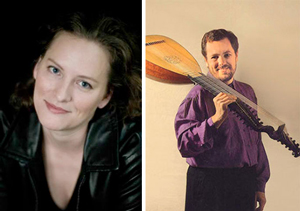by Nicholas Jones

Love, usually thought of in reference to a couple, became here a matter of the four players, sometimes flirting, sometimes fierce, sometimes laughing, sometimes in earnest, but clearly bound to each other in the bonds of the music.
Lovers, bound to each other, need to keep their own identities. And so it was in this “Portrait of Love” — each individual artist kept his or her sound and style. Two were regulars of Les Délices: founder and music director Debra Nagy, playing recorder and oboe; and the stellar Boston gambist Emily Walhout.
They played gorgeously, but the pièces de résistance of the feast were two guest artists. One was soprano Carrie Henneman Shaw (above) from St. Paul, possessed of a lucid voice, an irrepressible charm, a stunning command of French diction, and an ability to deliver a song narrative from four hundred years ago with utter certainty that it could have happened today.
The other guest was the international star, British lutenist Nigel North. For Les Délices to present an artist of this caliber is no small feat for a group only four years old. Nigel North’s musicality combines virtuosity — flying fingers, seemingly effortlessly presenting four-part polyphony on a single baroque lute — with a breathtaking gamut of emotional and tonal qualities. In North’s hands, the lute is not just a vestigial instrument from a forgotten time, but a way for us to understand and experience the intimate music of the late Renaissance and Baroque.
Intimacy was a key to the success of this concert. The welcoming space of Tregoning & Co.’s gallery created a sense of collectivity. The concert was set up with attention to sightlines and acoustic transparency, so that each of the perhaps 150 guests could see and hear. The gallery was full, even though a foot of snow was falling that evening, and my guess—from meeting guests at the reception after, and from the close attention paid to the music – was that these were knowledgeable listeners indeed. Many were members of the Cleveland Guitar Society, which collaborated with Les Délices to sponsor the concert.
I wrote recently in ClevelandClassical.com about the down-sides of presenting intimate chamber music (specifically, lute music) in a too-large venue. These problems were completely absent in Les Délices’s offering. The audience was close to the musicians, and the scale was totally appropriate to the acoustical qualities of the musicians. Instead of being spread through a church built to keep suburban listeners at a comfortable distance from each other, this venue pushed us together. The chairs were not particularly comfortable, but the closeness kept us in comfortable touch with the music and with the other listeners.
What happens with that closeness is that the music and its performance in the moment come alive. Near the end of the concert, a piece by Lully, Récit de la beauté, was performed. It was beautiful and sad; soprano Shaw’s sultry and jazzy rendition of love’s “belles chaines” (beautiful chains) was as penetrating as a Piaf ballad. Should a reviewer admit that he was moved to tears?
I should write about some of the details of the songs. The concert presented music that I’d wager few of us in the audience had heard before. Lully was by far the most famous name in the program. The first section was from early 17th-century music: lute pieces by Robert Ballard, and courtly songs by Pierre Guédron and Gabrielle Bataille. The songs were apparently arrangements, originally composed for multiple voices; but here performed by a single voice, with the lute, continuo, and recorder providing the polyphony. They were strophic songs — in stanzas, like ballads — presented with a sensitive variety of instrumentation and voicing.
In one, Guédron’s “Ma bergère non légère en amours,” Shaw dazzled with her command of the French patter song, moving about the difficult French consonants even faster (I think) than the lutenist’s fingers.
The early 17th-century songs were succeeded by songs from later in the same century, in the bigger Baroque mode. North put down his lute and took up the theorbo, that complicated Baroque equivalent of the electric guitar. Nagy put down the recorder and took up the oboe. The intensity of feeling had been present from the opening; now the acoustic scale rose to match it in songs of abandonment, unrequited love—and, not to be too gloomy, shared passion.
The passion was conveyed in no small part by the gripping ornamentation in the vocal line. Carrie Shaw marked the key words with intense and sudden slides, dark vocal mordents, and subtle, momentary shakes. The effect was to bring the Mediterranean south into these French songs, like the dark, tragic sound of Portuguese fado.
The last song in the program was Michel Lambert’s Vos mepris chaque jour — “your scorn causes me a thousand anxieties each day.” Its haunting melody, I knew, came from some earlier source, but I could not pin it down. But in that knowledgeable audience, I trusted that someone would know. And indeed, a friend nailed the source for me — the gorgeous duet “Pur ti miro” from Monteverdi’s Coronation of Poppea. The hits keep coming!
The lyrics of Lambert’s song sum up the concert for me: “I would die of pleasure if I were happier.”
Nicholas Jones is Professor of English at Oberlin College and a keen amateur musician.
Published on ClevelandClassical.com February 19, 2013
Click here for a printable version of this article.



